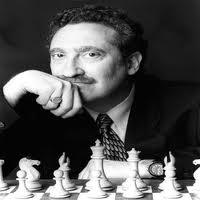
Pandolfini's Puzzler #44 - Take, Take and Mate?
Professor: What do you say, class?
Class: (Mumbled voices.)
Professor: It’s great that I have a captivated audience.
Hale: Captivated or captive?
Professor: Now that I’ve captured your attention, let’s talk about captures.
Lucian: What kind of captures?
Professor: The kind where you take pieces and pawns off the board.
Ryan: I try to do that every game.
Professor: Perhaps, but some of us take too much.
Hale: The more the merrier.
Zephyr: Well, up to a point. Once in control, you should mate as soon as you can.
Lucian: Didn’t Fischer say you should “take, take and mate?”
Hale: That’s not what he said.
Lucian: What did he say?
Hale: What was I, a fly on the wall? You’ll have to discover it for yourself.
Professor: Enough snarkiness. Let’s start by looking at a position that does emphasize capturing (and discovering).
Question 1: How can White force a win?
This was hardly a problem for the dynamic four. Everyone, even the flies in the room, sensed where to go at once.
Lucian: Wow! That really was simple.
Zephyr: It was just a straightforward windmill attack.
Hale: Can we see another problem?
Professor: Certainly. Try this next one.
Question 2: How can White force a win?
Here the class explored a few ideas. It didn’t take long before the core four found the answer, details and all.
Zephyr: Isn’t that an old Horwitz problem?
Professor: Very good! Just for that indispensable factoid, I’m going to give you another problem.
Question 3: Can White force a win?
Once again, the impetuous juveniles got their ideas quickly. To be sure, the position was solved in a “New York minute.”
Zephyr: The problem does have its charm.
Hale: Yeah, I like the diagnostics of discovering diagonalized windmills.
Lucian: Aha.
Professor: Perhaps you’re aware it was composed by F. Bondarenko and first published in L’Italia Scacchistica in 1961?
Ryan: Actually, we weren’t sure of the year.
Professor: Let’s go back to Horwitz. Here’s a problem he published in 1881, at least according to my notes.
Question 4: Can White force a win?
Lucian: What’s happening here, Professor?
Professor: Some people call this a “checkers problem.”
Zephyr: Like the game of checkers?
Professor: Kind of.
Lucian: Why do they call it that?
Ryan: Because the captures are essentially compelled.
Hale: I can’t stand when they do that in movies and television.
Zephyr: When they do what?
Hale: When they have a kid jump four or five checkers in a row.
Lucian: It’s so clichéd.
Professor: Clichéd or not, let’s see one more problem. I’ll even make it a little harder.
Zephyr: Oh goody, finally, a harder problem.
Question 5: How can White mate in 64 moves?
Ryan: What’s going on here, Professor?
Professor: How do I put this?
Hale: Just put it.
Professor: All right. It’s an old D.G. Reichhelm problem from probably the 1880s.
Zephyr: We need more than that.
Professor: OK. To summarize, you have to capture most of Black’s forces and give mate on the 64th move.
Class: Huh?
Professor: And I’ll need good explanations, too – with supportive analysis.
So the class began to analyze. They analyzed and analyzed and analyzed some more.
Hale: Incredible! Professor, our time is up.
Professor: So, do the problem for homework. Get it completely right and you’ll win an algebraic version of Fischer’s “My 60 Memorable Games.”
Ryan: All four of us?
Professor: All four of you, if you all do a nice job.
Lucian: I wonder what Fischer would say about that.
Zephyr: I know what you’d say he’d say.
Lucian: What?
Zephyr: “Just take, take and mate.”
Answers below - Try to solve ProfessorPando's Puzzle first!
ANSWER #44
For problem 1, White has a decisive windmill attack, leading to the capture of most of Black’s material. The winning variation is 1. Rxg7+ Kh8 2. Rxf7+ Kg8 (2…Bf6 3. Bxf6+ doesn’t help Black at all) 3. Rg7+ Kh8 4. Rxe7+ Kg8 5. Rg7+ Kh8 6. Rxd7+ Kg8 7. Rg7+ Kh8 8. Rxc7+ Kg8 9. Rg7+ Kh8 10. Rxb7+ Kg8 11. Rg7+ Kh8 12. Rxa7+ Kg8 13. Rxa8, and White has an easily won game.
For problem 2, composed by Horwitz in the 1800s, White uses recurring mate threats to pick off a lot of Black’s stuff. The winning line is 1. Ne4 (note that 1. Rb1+ Kf2 2. Ne4+ Kf3 3. Rxg1 h2 is a problem) Bc1 (or 1…Kd1) 2. Rb1 Kd1 3. Nf2+ Ke1 4. Nxg4 (threatening mate) Kd15. Nf2+ Ke1 6. Nxh3 Kd1 7. Nxg1, and Black loses the bishop as well.
For problem 3, White cleans Black out with a diagonal windmill: 1. Rh8+! Kxh8 2. Rc8+ Kh7 3. Bg8+ Kh8. The fun continues with 4. Bxe6+ Kh7 5. Bg8+ Kh8 6. Bxd5+ Kh7 7. Bg8+ Kh8 8. Bxc4+ Kh7 9. Bg8+ Kh8 10. Bxb3+ Kh7 11. Bg8+ Kh8 12. Bxa2+ Kh7 13. Bg8+ Kh8 14. Bb3+! Kh7 15. Bxc2+ Qxc2 16. Rxc2, with a basic mate in sight.
For problem 4, the solution falls into the category of a true “checkers combination,” where Black is compelled to capture in self-harmful ways. The winning line is 1. axb8/Q+ Qxb8 (essentially, a compulsory capture) 2. Bd6+! Qxd6 (chessically compelled) 3. Rxd2+ Qxd2 (once again, practically compelled) 4. Nxf3+, and Black is reduced to nothing. Naturally, we’re going to assume you know how to mate with bishop and knight.
That brings us to problem 5, the one the kids had to do for homework. Ugh. As you might have figured out, it begins with a capture and a discovery, 1.Kxc3+ (scroll down for diagram of all moves).
In this first stage, White captures all of Black’s forces except the queen and pawns.
The main line continues: 1...Kb1 2.Qxf5+ Ka2. If Black plays 2. ... Kc1 instead, White wins at once with 3. Qc2 mate.
So 3.Qf7+ Kb1 4.Qh7+ Ka2 (now the first knight goes) 5.Qxg8+.
The variation continues: 5…Kb1 6.Qh7+ Ka2 (as before, 6…Kc1 is met by 7. Qc2 mate) 7.Qf7+ Kb1 8.Qf5+ Ka29.Qd5+ Kb1 10.Qd3+ Ka2 11.Qc4+ Kb1 (and now a rook goes) 12.Qxf1+.
The line continues: 12…Ka2 13.Qc4+ Kb1 14.Qe4+ Ka2 15.Qd5+ Kb1 16.Qxh1+ (there goes the 2nd knight) Ka2 17.Qd5+ Kb1 18.Qd3+ Ka2 19.Qc4+ Kb1 20.Qxa6 (bye bye 2nd rook).
That ends the first stage. Black is no longer in check.
If Black plays 20…Qa2, White has 21. Qf1 mate.
If Black plays 20…a2, White has 21. Qf1 mate as well.
The try 20…Kc1 also ends in 21. Qf1 mate.
So Black seemingly is reduced to pawn moves. Perhaps the trickiest one is 20…g2. White then has 21. Qd3+ Ka2 22. Qd5+ Kb1 23. Qxg2, and the deadly g-pawn falls, with White still in control.
Since Black still can’t block a2 without consequence (by 23…a2 or 23…Qa2) because of 24. Qf1 mate, the only other non-pawn-move try for Black is 20…Ka2. To maintain control, White then plays 21. Qe6+ Kb1 22. Qc4.
In this general setup, White wants it to be Black’s move, which puts Black in a kind of zugzwang.
If it were White’s move, White could force the same setup with Black to move. The trick is to triangulate the queen (say, working with e4, e6 and c4). So, with White to move in the position above, the play would go 1. Qe4+ Ka2 2. Qe6+ (or 2. Qd5+) Kb1 and then 3. Qc4, creating the same position but with Black to move.
After 22. Qc4, Black has more or less 4 different ideas.
Black can play
(A) 22…Kc1;
(B) 22…Qa2;
(C) 22…a2;
(D) or any of six other pawn moves.
-
If Black plays 22…Kc1, then 23. Qf1 is mate.
-
If Black plays 22…Qa2, then 23. Qf1 is also mate.
-
If Black plays 22…a2, then White once again has 23. Qf1 mate.
-
If Black moves any of his other pawns, White triangulates until the white queen can capture a pawn and still keep mate in view. Thereafter, the maneuvering repeats and continues.
Back to the real setup, with it being Black’s move. Let’s say Black plays 22…h4. Of course, White can’t play 23. Qxh4??, allowing Black to promote at f1.
So after 22…h4, a more likely continuation is 23. Qe4+ Ka2 24. Qe6+ Kb1 25. Qc4 (completing another e4-e6-c4 triangulation).
If Black then plays 25...h5 (to delay advancing the h4-pawn to h3, where it’s quickly lost), the line proceeds 26. Qe4+ Ka2 27. Qe6+ (yes, 27. Qd5+ also works) Kb1 28. Qc4 (another e4-e6-c4 triangulation) c6 (still trying to delay matters, especially the advance h4-h3) 29. Qe4+ Ka2 30. Qe6+ Kb1 31. Qc4 (completing the same triangulation).
At this point, Black could try various pawn moves. Let’s say he tries to upset the applecart with 31...g2. Now that dangerous pawn falls. After 32.Qe4+ Ka2, White delays capturing the g-pawn until the black king is sitting on b1. Once the black king is on b1, the black queen is unable to get out of the corner.
So play continues 33. Qe6+ Kb1 34. Qg6+ Ka2 35. Qg8+ Kb1. Here, with the black king at b1, the white queen can take the g-pawn. The variation continues 36. Qxg2 Ka2 37. Qg8+ Kb1 38. Qc4, which compels Black to move another pawn.
Moving ahead, we have 38...c5 39. Qe4+ Ka2 40. Qe6+ Kb1 41. Qc4 41...h3.
The h3-Pawn is now lost: 42. Qe4+ Ka2 43. Qe6+ Kb1 44. Qxh3 Ka2 45.Qe6+ Kb1 46. Qc4. Now it starts all over again. After 46...h4, the play continues 47. Qe4+ Ka2 48. Qe6+ Kb1 49. Qc4 h3.
The new h3-pawn is won by 50. Qe4+ Ka2 51. Qe6+ Kb1 52. Qxh3.
Play resumes 52…Ka2 53. Qe6+ Kb1 54. Qc4 (arriving at our friendly zugzwang setup once again).
A plausible continuation is 54...e2 55. Qxe2 Ka2 56. Qe6+.
The choice now is to move the black king or to block the check by playing c5-c4. Black can live for at least an extra move by playing the pawn move, so 56...c4 (or 56. ... Kb1 57. Qc4 f1/Q 58. Qxf1+ Ka2 59. Qc4+ Kb1 60. Qxc5 Ka2 61. Qd5+ Kb1 62. Qc4 Qa2 63. Qf1 mate) 57.Qxc4+ Kb1 58. Qe4+ Ka2 59. Qe6+ Kb1 60. Qc4 f1/Q 61.Qxf1+ Ka2 62. Qf7+ Kb1 63.Qc4, and it is mate next move.
If 63…a2, then 64. Qf1 mate; if 63..Qa2, then 64. Qf1 mate; and if 63..Kc1, once again, matters are concluded by 64. Qf1 mate.
Take note
Just as Humphrey Bogart never quite said, “Play it again, Sam,” in the movie Casablanca, Fischer’s famous line from My 60 Memorable Games about sacrificing is typically misquoted. Let’s look at what he really said and its context. Referring to a game he played against Bent Larsen, with Larsen having the black side of the Sicilian Dragon, and after Fischer had retreated his king's bishop (16.Bd5-b3!), Bobby actually said:
“He won’t get a second chance to snap off the bishop! Now I felt the game was in the bag if I didn’t botch it. I’d won dozens of skittles games in analogous positions and had it down to a science: pry open the KR-file, sac, sac . . . mate!”
But even here we don’t know what Fischer truly said, since, to make it read better, the text was put into printable language by grandmaster Larry Evans. If only we could have been a fly on the wall who plays chess.
RELATED STUDY MATERIAL
- Watch: How to do the bishop and knight mate - parts one and two, and the Computer Workout for practice;
- See an explanation of zugzwang and some examples from GM Benzoo;
- Coach Amori has a great endgame on display from Fischer!






